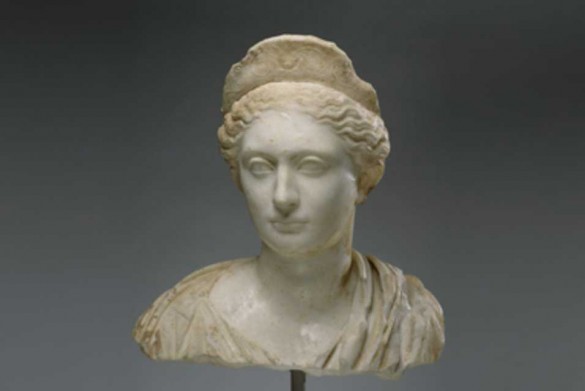Getty Museum Opens Exhibition Featuring J. Paul Getty’s Antiquities
LOS ANGELES, CA.- Celebrating 70 years of collecting, Collector’s Choice: J. Paul Getty and His Antiquities, on view from November 18, 2009–February 8, 2010, at the J. Paul Getty Museum at the Getty Villa, presents seldom-seen works of art that captured J. Paul Getty’s eye and inspired the creation of a museum modeled on an ancient Roman villa. Favored objects and personal memorabilia illuminate Mr. Getty’s taste, his engagement with noted connoisseurs, and his profound love of the classical Mediterranean world.

Unknown, "Bust of a Woman", about 130. Roman, Marble. Object: H: 43 X W: 42.1 X D (head). 70.AA.100. The J. Paul Getty Museum, Villa Collection, Malibu, California.
“This exhibition coincides with the 70th anniversary of Mr. Getty’s first antiquities purchase and provides an opportunity to share insights about his art pursuits, giving visitors a sense of his passion for the classical world,” says Michael Brand, director of the Getty Museum. “His collecting practices and keen business acumen set the stage for one of the most important collections of Greek and Roman art in the United States.”
With his first antiquities purchase in 1939, J. Paul Getty (American, 1892–1976) embarked on a lifelong pursuit of “true and lasting beauty.” By then, he was firmly established as a successful oilman, well on his way to becoming known as the world’s richest individual. His personality and taste deeply marked the formation of his collection and gave it a distinct oldworld profile.
Collector’s Choice presents objects from Mr. Getty’s original collection of antiquities, now in the collection of the J. Paul Getty Museum as well as photographs, letters, and historical records from the Getty Research Institute. The exhibition includes art works with distinguished pasts such as the Mazarin Venus, Roman, A.D. 100–200, which was once part of the royal holdings of France, as well as personal favorites such as the fine head of a young woman, made in Athens, about 320 B.C, which was chosen for the cover of Mr. Getty’s book The Joys of Collecting and remained one of his prized possessions for almost two decades.
The exhibition highlights the relationship between a collector and his collection. J. Paul Getty was attracted to statues of divinities and heroes such as the Lansdowne Herakles, (Roman, about A.D. 125) on view in the permanent galleries. His sentimental approach also made him partial to depictions of children and animals. The presentation pairs objects with items such as letters, articles, and photographs that underscore Getty’s personal connection with the object and exemplify why he purchased it.
“Mr. Getty believed the formation of a collection should first and foremost reflect the taste of the collector,” explains Laure Marest-Caffey, exhibition co-curator and curatorial assistant for the Getty Museum’s Antiquities department. “As is the case with other private collectors, his personality greatly marked the formation of his collection. His vision culminated in the most striking expression of his passion for the classical Mediterranean world: the creation of a museum modeled on an ancient Roman villa.”
Marest-Caffey co-curated the exhibition with Jens Daehner, associate curator for the Getty Museum’s Antiquities department.
Related posts:
- The J. Paul Getty Museum Observes Day Without Art
- Getty Museum to Exhibit Photographs by Frederick H. Evans
- Getty Exhibition Explores Three Cities through Three Contemporary Photographers
- International Scholars Come Together for a Symposium at the Getty Museum
- Exhibition Featuring 30 Artists Explores Hair as a Subject and Medium
